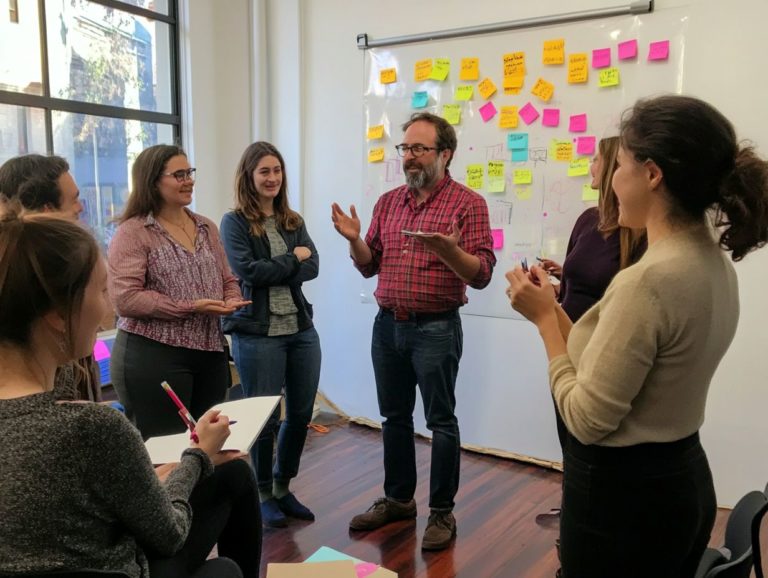How to Create an Inclusive Corporate Training Program?
In today s diverse workplace, creating an inclusive environment through corporate training is more vital than ever.
This article explores why inclusion matters more than ever, highlighting its importance in boosting employee engagement and productivity. You ll discover existing gaps in current training programs and uncover the key elements that truly make training inclusive.
We ll discuss strategies for effective implementation and methods to measure success. Join in as you learn how to sustain and enhance inclusive practices that will benefit everyone in your organization.
Contents
- Key Takeaways:
- Understanding Inclusion in Corporate Training
- Identifying Inclusion Gaps in Current Training Programs
- Key Elements of an Inclusive Corporate Training Program
- Strategies for Implementing an Inclusive Training Program
- Measuring the Success of an Inclusive Training Program
- Continuing to Foster Inclusion in the Workplace
- Frequently Asked Questions
- What is an inclusive corporate training program?
- Why is it important to have an inclusive corporate training program?
- How do I create an inclusive corporate training program?
- What topics should be included in an inclusive corporate training program?
- How can I ensure the success of an inclusive corporate training program?
- What are the benefits of an inclusive corporate training program?
Key Takeaways:

- Discover why inclusion in corporate training is crucial for your company culture and employee performance.
- Learn to spot and fill gaps in your current training programs with diversity and inclusion principles.
- Implement diverse training methods to create a successful and sustainable inclusive training approach.
Understanding Inclusion in Corporate Training
Understanding the importance of inclusion in corporate training is essential for cultivating a positive workplace culture and advancing your organization s mission. When all employees, regardless of their diverse backgrounds, feel valued and enabled, everyone benefits.
Inclusion is key to enhancing employee retention and driving effective engagement strategies. It aligns training programs with diversity and inclusion principles.
Effective training programs can address crucial aspects of diversity, such as representation. This not only reduces workplace discrimination but also fosters a culture where every employee can thrive. By prioritizing these elements, you can significantly elevate your organization s training initiatives and overall performance.
Defining Inclusion and Its Importance
Inclusion is about crafting an environment where diverse individuals feel welcome, respected, and valued in the workplace culture, enabling them to fully engage in corporate training initiatives.
This concept transcends mere representation; it s about actively involving every employee and ensuring their unique perspectives inform decision-making processes. When you prioritize inclusion, you foster a supportive atmosphere that encourages open communication and collaboration.
This proactive engagement greatly enhances employee feedback mechanisms, leading to deeper insights that shape organizational practices and promote equity.
Effective inclusion strategies directly impact diversity policies, nurturing a progressive work environment that not only attracts but also retains top talent from various backgrounds. This, in turn, drives innovation and growth, setting the stage for success.
Identifying Inclusion Gaps in Current Training Programs
Identifying inclusion gaps in your current training programs is essential for recognizing areas that require improvement. By doing this, you can transform your approach to meet diverse needs, ultimately enhancing the impact of your corporate training initiatives.
Evaluating Existing Training Programs
Evaluating existing training programs requires a structured way to assess their effectiveness in promoting inclusion and meeting established training objectives.
To accomplish this, you must implement comprehensive feedback processes that gather insights from participants, trainers, and stakeholders alike. By collecting feedback from various sources, these mechanisms can uncover valuable perspectives on the training content, delivery methods, and overall receptiveness of the material.
Integrating inclusion training is essential; it nurtures a culture of belonging and ensures that diverse perspectives are considered during evaluation. This multifaceted approach enables you to refine your training initiatives, tailoring them to equip employees with the skills necessary for inclusive practices and leading to more effective outcomes.
Key Elements of an Inclusive Corporate Training Program

Key elements of an inclusive corporate training program include diversity and inclusion principles.
Effective training strategies and diverse training materials are essential.
By catering to various learning styles, you can significantly enhance learner engagement and create a more enriching training experience.
Incorporating Diversity and Inclusion Principles
Incorporating diversity and inclusion principles into your training program design is crucial for cultivating a workplace that supports diverse employees and enhances retention.
By embedding these principles into your training curricula, you create an environment where every employee feels valued and understood. This strategy promotes open dialogue and mutual respect, allowing individuals from various backgrounds to share their unique perspectives.
Integrating real-world scenarios and case studies enriches understanding and helps dismantle hidden biases. Effective training programs do more than develop skills; they foster loyalty and commitment among employees, reducing turnover rates and driving organizational success.
Addressing Hidden Biases
Addressing hidden biases in training programs is essential for minimizing workplace discrimination and cultivating an inclusive environment.
Raising awareness of these biases fosters a culture of openness and mutual respect. Consider implementing interactive workshops that immerse team members in scenarios spotlighting bias, allowing them to grasp its practical implications firsthand.
Encourage open discussions that inspire growth! When employees embrace diverse perspectives and challenge their assumptions, it enhances their individual growth and paves the way for a more equitable workplace. This leads to improved collaboration and sparks innovation throughout the organization.
Strategies for Implementing an Inclusive Training Program
When you implement an inclusive training program, choose training materials that resonate with different learning styles to connect with everyone. Engaging employees in the training process fosters a sense of ownership and investment in their learning journey.
Training Delivery Methods and Materials
Training delivery methods and materials significantly shape the learning environment for diverse populations, ensuring that digital learning formats remain accessible to all.
Choosing the right methods can dramatically enhance engagement. Explore various technologies and approaches that cater to every learner’s needs. Incorporating a harmonious blend of visual, auditory, and kinesthetic elements fosters inclusivity and accommodates different learning styles.
For example, pairing interactive online modules with downloadable resources ensures that everyone can access information in their preferred format. By understanding your learners’ backgrounds and preferences, you can adapt course formats, creating an educational experience that is both enriching and approachable for all. This thoughtful approach ultimately leads to better outcomes in diverse settings.
Involving Employees in the Training Process

Involving employees in the training process is essential. It fosters participation and engagement, enhancing workplace inclusivity and training effectiveness.
Actively integrating their insights and experiences helps create a training environment that resonates with your team.
Encouraging training sessions where employees teach each other cultivates collaboration and shared knowledge. As team members transition from observers to participants, their enthusiasm flourishes. This transforms training into a dynamic exchange of ideas and experiences that benefits everyone involved.
This approach boosts knowledge retention and helps employees feel a sense of ownership in their personal and organizational growth.
Measuring the Success of an Inclusive Training Program
Measuring the success of an inclusive training program is vital for assessing its impact on training effectiveness. This process also allows you to gather invaluable employee feedback to guide future initiatives.
Identifying Key Metrics and Evaluation Methods
Identifying key metrics and evaluation methods is foundational in assessing the effectiveness of an inclusive training program. It ensures that the program meets the needs of your diverse workforce.
Establishing qualitative and quantitative benchmarks is essential. Consider participant retention rates, knowledge assessments, and how well skills are applied in real-world scenarios. Gathering feedback from employees through surveys and focus groups provides invaluable insights into their experiences and satisfaction with the training.
This feedback can guide you in developing tailored engagement strategies that resonate with various learning styles and cultural backgrounds. Ultimately, this enhances the training s relevance and impact.
By continuously evaluating these elements, organizations can refine their approaches, creating an environment where employees feel equipped and enabled to contribute meaningfully.
Continuing to Foster Inclusion in the Workplace
To cultivate inclusion in the workplace, you must be dedicated to sustaining and enhancing inclusive practices. It s essential that diversity policies are actively integrated into your training programs. This commitment enables a workplace where everyone feels valued and enabled.
Sustaining and Improving Inclusive Practices
Sustaining and enhancing inclusive practices in the workplace is a continuous journey. It necessitates regular evaluation of your employee training programs and their alignment with diversity and inclusion goals.
This approach ensures that the training resonates with your team members and adapts to the evolving workplace culture.
Implement regular feedback mechanisms to pinpoint gaps in understanding or skills. By cultivating an environment where inclusivity is a priority, you help employees feel valued and enabled. This, in turn, drives engagement and fosters innovation.
Integrating these practices with broader diversity initiatives reinforces a shared commitment to fairness and respect, ensuring everyone participates in nurturing an inclusive environment.
Frequently Asked Questions

What is an inclusive corporate training program?
An inclusive corporate training program is a learning and development initiative designed to promote diversity and inclusion within the workplace. It includes training on topics such as bias awareness, cultural competence, and creating a successful corporate training program to foster an inclusive work environment.
Why is it important to have an inclusive corporate training program?
Having an inclusive corporate training program is important because it helps create a more diverse and welcoming workplace. For guidance on this, consider exploring how to create an inclusive skill enhancement program. This approach can lead to increased employee satisfaction, improved teamwork, and better decision-making within the organization.
How do I create an inclusive corporate training program?
To create an inclusive corporate training program, start by assessing the current situation to identify any gaps in diversity and inclusion within the organization. Then, develop a custom corporate training program by creating training materials and selecting facilitators who are knowledgeable about diversity and inclusion.
What topics should be included in an inclusive corporate training program?
An inclusive corporate training program should cover topics such as unconscious bias, which refers to the attitudes or stereotypes that affect our understanding and decisions, often without us realizing it, cultural competence, inclusive language, and creating an inclusive work environment. It should also address specific issues or challenges that may be present within the organization.
How can I ensure the success of an inclusive corporate training program?
Involve all employees to ensure the success of the training program. Provide opportunities for open discussion and feedback, and follow up with additional resources and support. It is also crucial to have support from top-level management and to continuously evaluate and update the training program.
What are the benefits of an inclusive corporate training program?
An inclusive corporate training program can benefit both employees and the organization as a whole. It can lead to increased employee engagement and satisfaction, improved communication and collaboration, and a more diverse and inclusive workplace culture, following best practices for corporate training.
Creating an inclusive training program not only boosts employee satisfaction but also makes your workplace a thriving, dynamic environment. Act now to enhance your corporate culture and empower your team!






